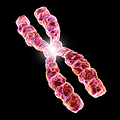Cytogenetics is the study of chromosomes and their role in heredity. Thus, this topic room is all about chromosomes: chromosome structure and composition, the methods that scientists use to analyze chromosomes, chromosome abnormalities associated with disease, the roles that chromosomes play in sex determination, and changes in chromosomes during evolution.
The field of cytogenetics emerged in the early twentieth century, when scientists realized that chromosomes are the physical carriers of genes. As is always the case in science, researchers built on the observations of their fellow investigators to synthesize the chromosome theory of heredity. This groundbreaking theory had its foundations in the detailed observations that cytologists had made about chromosome movements during mitosis and meiosis, which suggested that chromosome behavior could explain Mendel's principles of inheritance.
In the early years of cytogenetics, scientists had a difficult time distinguishing individual chromosomes, but over the years, they continued to refine the conditions for preserving and staining chromosomes to the reproducible standard that is now expected in clinical cytogenetics. (Looking back, it seems incredible that the human chromosome number was not established until 1955.) In today's procedures, metaphase chromosomes are treated with stains that generate distinctive banding patterns, and chromosome pairs are then arranged into a standardized format known as a karyotype. Among the members of a species, karyotypes are remarkably uniform, which has made it possible for cytogeneticists to detect various deviations in chromosome number and structure that are associated with disease states and developmental defects.
A normal human karyotype contains 22 pairs of autosomes and one pair of sex chromosomes. Aneuploidies, or changes in chromosome number, are easily detected on karyotypes. In humans, most aneuploidies are lethal because of the ensuing imbalance in gene expression. A notable exception is trisomy 21, or Down syndrome, which is frequently detected during prenatal screening of older mothers. Sex chromosome aneuploidies are also tolerated in humans, most likely because X inactivation maintains near-normal expression levels for X-linked genes. In addition to changes in chromosome number, karyotypes can also reveal more subtle changes in chromosome structure. In effect, the normal banding pattern of a chromosome provides a "bar code" that can be translated into a map of the chromosome. Cytogeneticists can then use coordinates on these rough chromosome maps, or idiograms, to identify the positions of structural abnormalities, including deletions, duplications, and translocations, to within a few megabases of DNA.
Over the past few decades, versatile methods based on fluorescence in situ hybridization (FISH) have transformed cytogenetics into a molecular science and provided cytogeneticists with powerful new tools. In FISH procedures, labeled DNA or RNA probes are hybridized with their complementary target DNA sequences on chromosomes. FISH experiments often generate colorful results, because multiple probes, each of which is labeled with a spectrally distinct fluorescent dye, can be used in the same experiment. The target DNA sequences may consist of either a single gene or a collection of genes spread out along the length of a chromosome. FISH procedures are now routinely employed in clinical cytogenetics. Spectral karyotyping provides an overview of any gross rearrangements and changes in chromosome number that have occurred in a patient's cells. Using gene-specific probes, cytogeneticists can also positively identify the genes affected by chromosomal mutations. More recently, researchers have additionally begun to employ comparative genomic hybridization to analyze small quantitative differences between individuals' DNA, including copy number variations (CNVs).
Outside the clinic, FISH is one of many techniques biologists use to investigate the structure of chromosomes and their organization within the nucleus. Although chromosomes may appear to be static structures when viewed under a microscope, cytogeneticists know that chromosomes are actually dynamic assemblies made up of a DNA-protein complex called chromatin. Chromatin undergoes dramatic changes in packing during the cell cycle, and its structure also varies locally along the length of each chromosome. Transcriptionally active chromatin, or euchromatin, has a different composition than silent chromatin, or heterochromatin. (The inactive X chromosome in female mammals is a special case in which heterochromatin extends along the entire length of a chromosome.) Some chromatin specializations are essential for normal chromosome behavior. For example, centromeres contain a unique chromatin that is required for chromosome attachment to the mitotic spindle. Likewise, chromosome integrity depends on the assembly of a specialized chromatin found exclusively at the telomeres. Other less defined aspects of chromosome structure may also be important in positioning individual chromosomes with the nucleus. For instance, mounting evidence seems to indicate that chromosomes occupy discrete territories in the interphase nucleus; this marks a significant departure from the previously accepted idea that chromosomes are randomly organized during interphase.
In this era of comparative genomics, cytogenetics is also offering insights into evolution. Using cross-species FISH, scientists have identified groups of genes, called synteny groups, that maintain the same linkage relationships with each other across species boundaries. Synteny data reveal numerous chromosomal rearrangements that have occurred during the course of evolution. Taken together with DNA sequence information, synteny data are proving useful for detecting genome duplications and for constructing phylogenetic trees.
The collection of articles in this topic room is intended to provide students with an introduction to chromosome biology and an appreciation of the experimental evidence that has led to the current state of understanding. Cytogenetics is a broad and growing field of research, and many topics have not been discussed in detail. The editors hope that this collection will grow over time as new discoveries are made and gaps in the current collection are filled. To this end, teachers and researchers are encouraged to contribute new articles to the collection after consultation with the editors.
Image: Mehau Kulyk/Science Photo Library/Getty Images.













